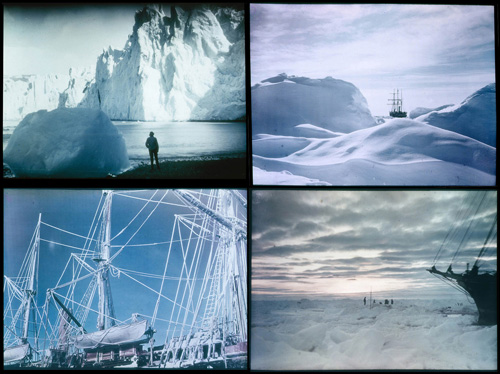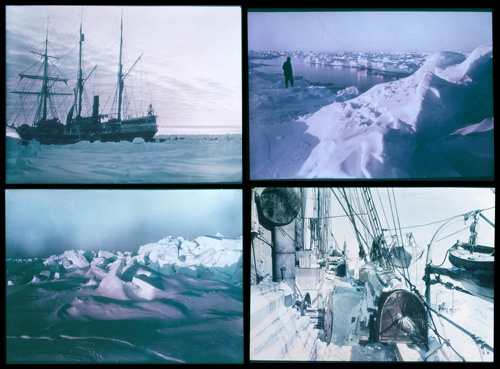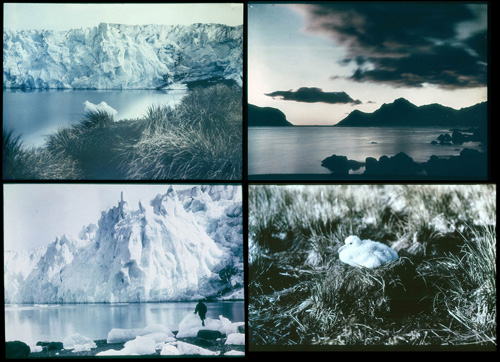Frank Hurley was an Australian photographer and adventurer, most famous for his series of artful photographs documenting Shackleton's epic 'Endurance' expedition of 1914-17. While the black-and-white images are well-known, a less familiar but equally stunning set of his color pictures was recently put online by the State Library of New South Wales in Sydney. I thought I'd share some of them here.  The color photographs were taken in 1915, the year the Endurance was crushed by Antarctic ice in the Weddell Sea. They are among 120 glass plates in total that Shackleton and Hurley chose to retrieve from the sinking ship. The captain and photographer then smashed the remaining 400 plates to eliminate any temptation of taking them along, recognizing that the party's survival depended on meeting space and weight limitations. The crew did endure their perilous 500-day ordeal, as did the 120 photographic plates which they hauled by sledge and lifeboat, now allowing us a glimpse into one of polar history's most dramatic voyages.
The color photographs were taken in 1915, the year the Endurance was crushed by Antarctic ice in the Weddell Sea. They are among 120 glass plates in total that Shackleton and Hurley chose to retrieve from the sinking ship. The captain and photographer then smashed the remaining 400 plates to eliminate any temptation of taking them along, recognizing that the party's survival depended on meeting space and weight limitations. The crew did endure their perilous 500-day ordeal, as did the 120 photographic plates which they hauled by sledge and lifeboat, now allowing us a glimpse into one of polar history's most dramatic voyages.  Frank Hurley considered his color photos “amongst the most valuable records of the expedition.” He used an early polychrome process called Paget, which was patented in 1912 in England and remained in use until the 1920s. Paget used two plates, one a traditional black-and-white negative, the other a red, green, and blue screen scored with a pattern of dots and lines. The negative was contact-printed to made a transparency positive which was combined with the matching color screen to achieve the final image. The process was eventually eclipsed by the truer, richer colors captured by autochrome and later by Koda- chrome.
Frank Hurley considered his color photos “amongst the most valuable records of the expedition.” He used an early polychrome process called Paget, which was patented in 1912 in England and remained in use until the 1920s. Paget used two plates, one a traditional black-and-white negative, the other a red, green, and blue screen scored with a pattern of dots and lines. The negative was contact-printed to made a transparency positive which was combined with the matching color screen to achieve the final image. The process was eventually eclipsed by the truer, richer colors captured by autochrome and later by Koda- chrome.  The Endurance was the second of Hurley's three voyages to Antarctica. His first was as official photographer to Douglas Mawson's Australasian Antarctic Expedition of 1911-14 which brought him to Shackleton's attention. In 1914, Hurley was signed on to the Endurance venture where he continued raising exploration photography to new levels through unique compositions and storytelling with both still and movie cameras. His achievements are all the more impressive for the extreme conditions he braved. He climbed masts, traversed splitting ice floes, and trekked in subfreezing temperatures — often at night — to take his innovative photos. Lionel Greenstreet, the Endurance's First Officer, wrote of him: “Hurley is a warrior with his camera & would go anywhere or do anything to get a picture.”
The Endurance was the second of Hurley's three voyages to Antarctica. His first was as official photographer to Douglas Mawson's Australasian Antarctic Expedition of 1911-14 which brought him to Shackleton's attention. In 1914, Hurley was signed on to the Endurance venture where he continued raising exploration photography to new levels through unique compositions and storytelling with both still and movie cameras. His achievements are all the more impressive for the extreme conditions he braved. He climbed masts, traversed splitting ice floes, and trekked in subfreezing temperatures — often at night — to take his innovative photos. Lionel Greenstreet, the Endurance's First Officer, wrote of him: “Hurley is a warrior with his camera & would go anywhere or do anything to get a picture.”  Getting the pictures was only part of the challenge; developing them on the ice-trapped ship was another. The temperature in Hurley's darkroom hovered around freezing, and water for washing his plates was obtained by melting blocks of ice. He described the difficulty in his diary: "Washing plates is a most troublesome operation, as the tank must be kept warm or the plates become an enclosure in an ice block... Development is a source of annoyance to the fingers which split & crack around the nails in a painful manner.”
Getting the pictures was only part of the challenge; developing them on the ice-trapped ship was another. The temperature in Hurley's darkroom hovered around freezing, and water for washing his plates was obtained by melting blocks of ice. He described the difficulty in his diary: "Washing plates is a most troublesome operation, as the tank must be kept warm or the plates become an enclosure in an ice block... Development is a source of annoyance to the fingers which split & crack around the nails in a painful manner.”  In 1917, Hurley returned to South Georgia (pictured in the four photos above) for his final Antarctic filming expedition, culminating in the 1919 motion picture "In the Grip of the Polar Pack" featuring his footage of the Endurance expedition. The movie quickly became a critical and popular success, and his still photography also gained a wide audience as Shackleton featured it in his lecture tours. Hurley's original photography and footage more recently appeared in NOVA's giant-screen film Shackleton's Antarctic Adventure as well as Shackleton's Voyage of Endurance first broadcast on NOVA in 2002. The Royal Geographical Society in London currently curates Hurley's original glass plate negatives and his original prints are held by the Scott Polar Research Institute in Cambridge and the Macklin Collection in Aberdeen, Scotland. A comprehensive selection of Hurley's Paget color glass transparencies from the Endurance expedition is showcased by the State Library of New South Wales online.
In 1917, Hurley returned to South Georgia (pictured in the four photos above) for his final Antarctic filming expedition, culminating in the 1919 motion picture "In the Grip of the Polar Pack" featuring his footage of the Endurance expedition. The movie quickly became a critical and popular success, and his still photography also gained a wide audience as Shackleton featured it in his lecture tours. Hurley's original photography and footage more recently appeared in NOVA's giant-screen film Shackleton's Antarctic Adventure as well as Shackleton's Voyage of Endurance first broadcast on NOVA in 2002. The Royal Geographical Society in London currently curates Hurley's original glass plate negatives and his original prints are held by the Scott Polar Research Institute in Cambridge and the Macklin Collection in Aberdeen, Scotland. A comprehensive selection of Hurley's Paget color glass transparencies from the Endurance expedition is showcased by the State Library of New South Wales online.